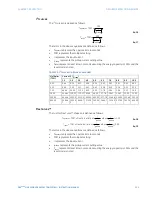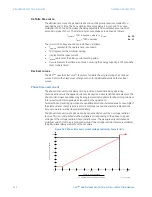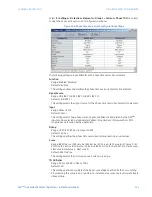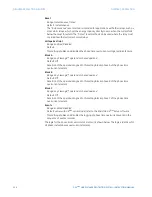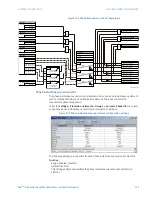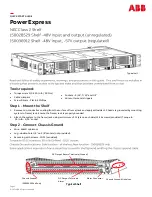
220
D90
PLUS
LINE DISTANCE PROTECTION SYSTEM – INSTRUCTION MANUAL
GROUPED PROTECTION ELEMENTS
CHAPTER 7: PROTECTION
current supervision above the maximum load current and use the fuse failure function as
well. The current supervision prevents maloperation immediately after the fuse fail
condition giving some time for the fuse failure element to take over and block the distance
elements permanently. This is of a secondary importance for time-delayed zones 2 and up
as the fuse failure element has some extra time for guaranteed operation. The current
supervision may be set less than the maximum load current for the time delayed zones.
Blocking distance elements during fuse fail conditions may not be acceptable in some
applications or under some protection philosophies. Applied solutions may vary as follows.
•
Not using the fuse failure element for blocking at all.
•
Using the fuse failure element and modifying (through FlexLogic™ and multiple setting
groups mechanisms) other protection functions or other devices to provide some
protection after detecting fuse fail conditions and blocking the distance elements.
•
Using the fuse failure element and accepting the fact that the distance protection will
not respond to subsequent internal faults until the problem is addressed.
NOTE
NOTE:
To be fully operational, the fuse failure element must be enabled and its output FlexLogic™
operand must be indicated as the blocking signal for the selected protection elements.
For convenience, the current supervision threshold incorporates the
√
3 factor.
Phase distance zone 1 guidelines for the stepped distance scheme
As typically used for direct tripping, the zone 1 reach must be chosen so that it does not
extend beyond the far end(s) of the protected line. Zone 1 provides nominally
instantaneous protection for any phase fault within a pre-determined distance from the
relay location. To ensure that no overreach occurs, typically requires a setting of 80% to
90% of the line length, which covers CT and VT errors, relay inaccuracy and transient
overreach as well as uncertainty in the line impedance for each phase, although
transposition may minimize this latter concern.
The total device inaccuracy is less than 5%. This includes both steady state and transient
overreach, even when supplied from CVTs under the source impedance ratios (SIRs) of up
to 30.
Phase distance zone 2 guidelines for the stepped distance scheme
Zone 2 is an overreaching element, which essentially covers the final 10% to 20% of the
line length with a time delay. The additional function for the zone 2 is as a timed backup for
faults on the remote bus. The reach is typically set to 125% of the positive-sequence
impedance of the line to ensure operation, with an adequate margin, for a fault at 100% of
the line length. The necessary time delay must ensure that coordination is achieved with
the clearance of a close-in fault on the next line section, including the breaker operating
time.
The zone 2 time delay is typically set from 0.2 to 0.6 seconds, although this may have to be
reviewed more carefully if a short line terminates on the remote bus, since the two zone 2
elements may overlap and therefore not coordinate in a satisfactory manner.
Phase distance zone 3 guidelines for the stepped distance scheme
If a remote backup philosophy is followed, then the reach of this element must be set to
account for any infeed at the remote bus, plus the impedance of the longest line which
terminates on this remote bus. The time delay must coordinate with other time-delayed
protections on any remote line. Circuit loading limitations created by a long zone reach
may be overcome by using lens or quadrilateral characteristics, a load encroachment
supervising characteristic, or both. Consideration should also be given to a situation where


























